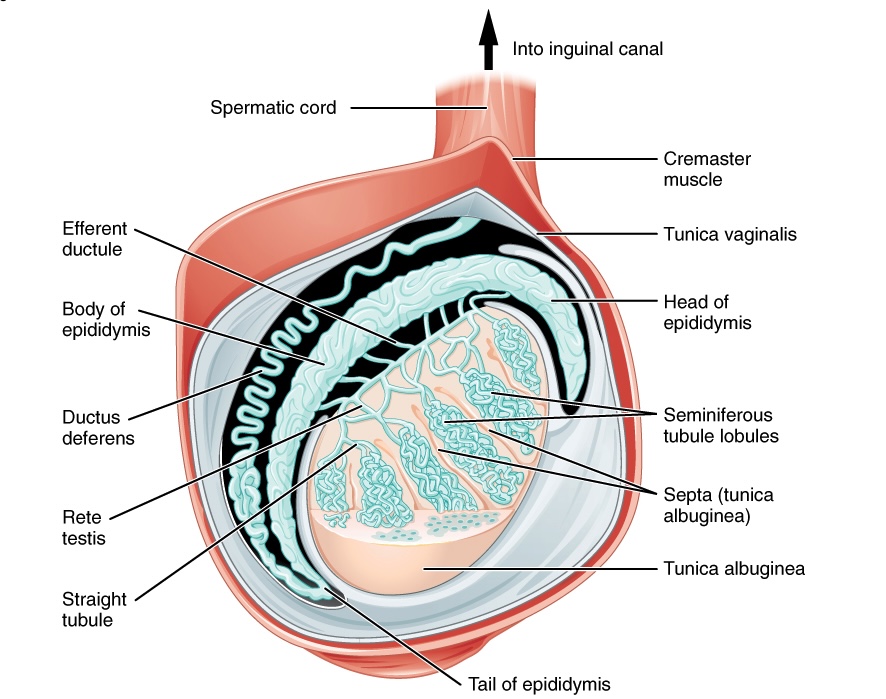Playlist
Show Playlist
Hide Playlist
Testis, Spermatogenesis and Sperm Maturation: Sertoli Cell Secretions
-
Slides Male Hormones Endocrine System.pdf
-
Download Lecture Overview
00:00 So what is the various testosterone doing and how does this affect spermatogenesis? We need to delve in a little bit deeper to the testis. Here in the testis, these Sertoli cells are going to be the primary spot in where spermatogenesis occurs. Leydig cells, remember, are located outside of where the Sertoli cells are. The Sertoli cells are where sperms start to develop. The testes are located outside of the body. They're located outside of the body because the temperature is cooler. It needs to maintain a slightly lower temperature than body temperature for spermatogenesis to occur. Therefore, these Sertoli cells are located right where they are for that particular reason. Sertoli cells need to be in close proximity to Leydig cells. Why? Because they need the testosterone that Leydig cells are producing because without that testosterone they're not going to undergo spermatogenesis and have the growth factor and regulatory peptides cannot work in the same way. Where do these growth factors and regulatory peptides come from? Sertoli cells. So really it's a combined effort for spermatogenesis to occur as well as for them to develop properly. So let's talk through that process in a little bit more detail. You need testosterone, androgen-binding protein. These testosterone levels need to be maintained at high levels and you need these growth factors for the spermatogenesis maturation process to occur. Spermatogenesis. Spermatogenesis is going to occur in the Sertoli cells. There is going to be a start of this process where you start to form a spermatid forming a primary then a secondary and eventually will fully develop into having both a head region and a tail but they're not quite fully developed yet. They need to have a fully developed head, a neck with a number of different mitochondria in it and a tail that's going to be able to work. At this particular point, the tail doesn't work yet. They basically cannot move. So how are they going to get to the epididymis? At this particular point, along the way there are cilia that will help move them along and this is the point where they're going to be able to fully mature. 02:38 Now, let's look at spermatogenesis in two specific ways. 02:43 One is which cell types we're talking about, and which meiotic division we are in. 02:49 The initial components are mainly involved DNA replication and the first meiotic division is in process when you have a primary spermatocyte. 03:02 Once the first meiotic division is complete as you can see in this diagram, you can now change into two secondary spermatocytes. 03:11 And this is the beginning of the second meiotic division. 03:15 As the second meiotic division is completed, now, you will have four spermatids. 03:22 Now, you can start to see how this process of amplification has happen as you've gone through the various meiotic divisions, and you'll eventually end up with spermatozoa. 03:34 So they wound up getting a little bit more ability to move or more motile. They also will gain the ability to fertilize and that cone region will be able to fully develop as well as get receptors for the female eggs that will be able to penetrate it. Finally, the last thing that they do is start to jettison their cytoplasma and mech of their cell volume. This way, they're really all going to have just the DNA, the mitochondria to help provide motile force for the tail and that flagella to get them to the right spot to do what they need to do.
About the Lecture
The lecture Testis, Spermatogenesis and Sperm Maturation: Sertoli Cell Secretions by Thad Wilson, PhD is from the course Reproductive Physiology.
Included Quiz Questions
Which of the following cell organelles are found in abundance in the neck of the sperm?
- Mitochondria
- Lipid vacuoles
- Glycogen vacuoles
- Centrioles
- Chromatin
At what point in spermatogenesis do secondary spermatocytes appear?
- End of 1st meiotic division
- End of 2nd mitotic division
- Beginning of 1st mitotic division
- Beginning of 2nd meiotic division
- Beginning of 1st meiotic division
How many cells have been produced by the completion of the 2nd meiotic division in spermatogenesis?
- 4
- 1
- 2
- 3
- 5
Customer reviews
5,0 of 5 stars
| 5 Stars |
|
2 |
| 4 Stars |
|
0 |
| 3 Stars |
|
0 |
| 2 Stars |
|
0 |
| 1 Star |
|
0 |
Very good lecture, I realy loved it, five stars thank you theacher
Concise yet fill with high yield information. I hope that the other lectures are similar to this one.





